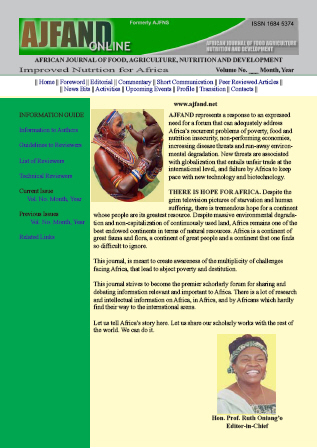
|
African Journal of Food, Agriculture, Nutrition and Development
Rural Outreach Program
ISSN: 1684-5358
EISSN: 1684-5358
Vol. 17, No. 1, 2017, pp. 11571-11591
|
 Bioline Code: nd17011
Bioline Code: nd17011
Full paper language: English
Document type: Research Article
Document available free of charge
|
|
|
African Journal of Food, Agriculture, Nutrition and Development, Vol. 17, No. 1, 2017, pp. 11571-11591
| en |
CHARTING THE COST OF NUTRITIONALLY-ADEQUATE DIETS IN UGANDA, 2000-2011
Omiat, G & Shively, G
Abstract
Although malnutrition rates have been on the decline in Uganda over the past two decades, they remain high. Challenges to achieving nutritional improvements result, in part, from high staple foods prices, which raise the cost of the food basket and increase the risk of food and nutrition insecurity, especially for poor households who are net buyers of staple foods. Nearly two-thirds of Ugandan households are net buyers of staples, a pattern that highlights the potential importance of food prices as a key driver of food insecurity. During 2007-2008 the country experienced particularly sharp increases in the prices of staple foods. This paper examines how price changes influenced the cost of obtaining a nutritionally-adequate diet in Uganda. Diet costs are measured across five representative locations over the period 2000 to 2011. A linear programming model and observed monthly food prices are used to compute the lowest-cost diets in five major markets for an adult male and adult female aged 19-50. The diet costs are computed under two scenarios: (i) subject to a range of nutrient-specific constraints (a basic diet), and (ii) with allowance for palatability constraints (a constrained diet). To compare food costs over time, prices are deflated using the monthly consumer price index (CPI). Food prices are converted to prices per 100 gram portions, so as to maintain consistency with units of nutrient composition for given food items. The diet cost is compared to the Ugandan poverty line over time. The real cost of obtaining a nutritionally-adequate diet with palatability constraints grew at a rate of three to nine percent per year per annum over the period 2000 to 2011. Diet costs (with palatability constraints) have exceeded the poverty line for most years since 2000, with the gap widening in the period 2007-2008. Results highlight the importance of food prices to overall nutrition, and document spatial heterogeneity in diet costs in Uganda. Findings underscore the importance of developing and supporting interventions that raise the purchasing power of the poor and increase nutrition education and outreach aimed at cost-effectively achieving dietary diversity. These results are limited by the fact that the researchers did not have data for vegetables, sweet potatoes, and sorghum (all commonly-consumed staples) as well as fats, oils, sugar and animal products.
Keywords
diets; food prices; linear programming; malnutrition; markets; poverty; staples; Uganda
|
| |
© Copyright 2017 - African Journal of Food, Agriculture, Nutrition and Development
Alternative site location: http://www.ajfand.net/
|
|
